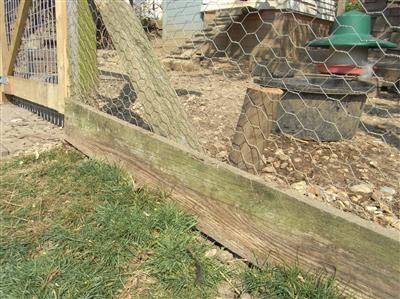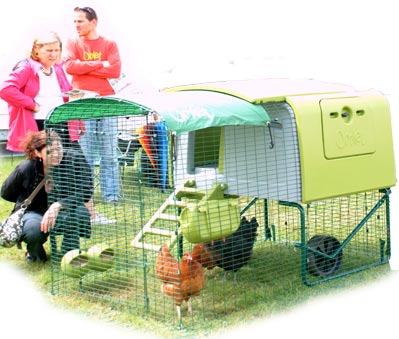There are a number of options when it comes to chicken fencing. All need to achieve two things though:
- Keep predators out (mainly the Fox in the UK but also Badgers in some areas).
- Keep your chickens where you want them.
The first is of course the highest priority to keep your chickens safe, I am happy to lose the odd plant if an escapee wanders onto the vegetable patch, this is soon forgotten about but discovering birds with their heads removed and bodies half buried is something you don’t forget for a long time, if at all.
So what are the options when it comes to fencing chickens? One of the best solutions for me has been an electric fence but this does come at a cost and requires regular maintenance. There is more information on the different kinds of electric fences on my Electric Fence page.
Chicken Wire
The good old fashioned way is to use galvanised chicken netting or rabbit wire as it is called in the trade. This needs to be at least 6 foot high and I say this because I have seen a fox leap up and scramble over the top of a 5 foot high chicken run fence when I found him inside one of my runs one morning. Wire needs to be buried in the ground about 8 inches, ideally 12 to be completely safe but if you bend the wire out, you can normally burry it 6 inches with a 6 inch overlap. If you are on sandy soil that is easier to dig, I would consider improving the depth of your chicken fencing.
Another option for securing the base further is to use boards around the base. This helps to keep any substrate inside the run (such as sand, gravel, or wood chips) but also secures the vulnerable bottom edge of the netting that is likely to get tugged and pulled at by a fox or badger and keeps the fencing rigid.
If, like me, you like your chicken run to look attractive, you can of course grow things up the outside of the fencing. I have in the past used a grape vine but the same could be done with many different climbing plants. Try to tie the plant to the wire, rather than threading it through to stop it from damaging the wire when it grows and rubs during the wind.
If chicken fencing is weak, foxes can and will tear at it to try to get in. If the wire isn’t taght or if there are weak points, don’t wait – fix it!
If you can’t find a local supplier of poultry wire – you may be able to find something suitable here.
Chicken Netting
Chicken fencing can be fairly straight forward if you are around during the daytime and don’t have a fox problem and would like to keep your chickens in a designated area. Omlet sell some chicken fencing that is a handy sized poultry netting complete with poles. This is a great idea as it allows you to easily change the shape and position of the chicken run to provide fresh pasture for them. It keeps your hens where you want them but remember this isn’t fox proof or electrified so should only be used to keep chickens in a given area when there isn’t a fox problem or when you’re around.
It is really good news for gardeners as you don’t want the chickens scratching up your beds or eating your new plants! If you turn this idea on its head, you can also use this netting to keep your chickens OFF your vegetables or garden by fencing the area off to stop them getting in!
It comes with a gate so that you can still get in and out with ease. There’s more information on the Omlet web page that you can reach by clicking the image below:







hello, i am getting 3 goldline chickens soon and i have the omlet chicken netting and i was wondering how big i should make the space where i put the netting? thank you.
There are different sizes of chicken fencing. Have a look at this review of the Omlet Chicken Netting. It has some good photos which should give you a good idea of the area you can fence.
Firstly: LOVE this page!
Starting up with 3 bantams and a “pet maran” in a few weeks time. The garden is about 0,5 acre, and I want the chickens to enjoy this space for a few hours every day. The run is about 8 sq.m.
But: How tall does the garden fence need to be to keep my ladies inside the garden? I live in Norway, so we don’t have the same fox-problem as in UK.
It depends on the breed. Flighty mediteranean breeds can fly well but larger fowl won’t = so I guess between 0.5 meters and 1.8 meters!
Hi, we’re in the process of building a run for our first chicken venture, 5.5m x 2.5m. Would the gavansed wire fencing which has 2 inch square holes (or possibly larger holes) be suitable? Thanks for the hepfull advice on the site.
Yes, it’s fine for fencing, however it does depend on the predators in your area. Badgers and large foxes for example are capable of tearing and wire so if there are lots of these around and your run is exposed then it might be better to put a stronger mesh or double layer at the lower level.
This site is fantastic for us new-bees.
I have just purchased a coop with suspended nest box’s and run attached (for 5 hens). I am getting 3 ex-bats that I hope will be in the coop when I’m not around and have the whole garden to roam when I am. Not only do I have fox’s but I have badgers too. Will my girls be safe at night/day or should I attach more wire and dig into the gound?
Umm hard to say without seeing the setup. I would certainly dig in the wire around the run to be on the safe side although the main risk comes at night.
Morning,
I have just purchased a coop (cocoon 2190) and hoping to keep 2 maybe 3 hens.
Im overwheled with info everywhere and just need to know what basic equpment I need in the coop and to get started.
Thankyou
Well, have a read of my page on Chicken Coops. A nest box, perches and pop hole are required and ventillation (but not draughts) is essential.
Outside the coop you’ll need feeder, water container and grit hopper. That’s about it!